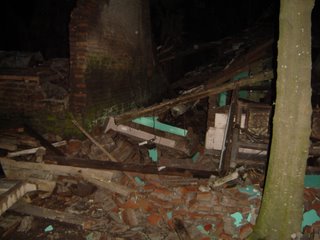Wednesday, May 31, 2006
Bantul and beyond

Link to Chad's VOA story from this excursion
Hi, this is Trish! I'm guest-blogging for Chad, who is still working like crazy down in Yogya. My job has brought me back to Jakarta. We're both fine, health- and safety- wise.
Night before last we headed into Bantul, which has become ground zero for aid workers and journalists. We weren't sure what we were looking for ... just something to record. What we found was a beat-up pickup truck full of teenagers, and a guy named Subardjo.
Subardjo is the kind of person reporters love. He makes things happen. Even though he has no formal education - his parents were too poor to send him to school - he's managed to start what's obviously a pretty lucrative business as a master woodworker. Oh, and he taught himself English on the side. Subardjo had gotten a million rupiah (about a hundred dollars) from a client earlier that day, so he'd promptly gone out and bought water, medical supplies and that Indonesian staple, ramen noodles. He was driving around to all the little villages where he knows people, dropping off supplies.
"Jump in," he said. How could we say no? We jumped in.
The truck turned up a narrow dirt road. There's no electricity, hence no electric lights, so the stars were really bright. We were in the truck bed, with the whole sky open above us. I just stared up and gorged myself on stars, because we never see them in Jakarta. Then we passed an open field with hundreds of fireflies: stars above, stars below.
When we got to the village, everybody came out to say hello. There were tarps strung up to make big tents; it looked like twenty or thirty people per tent. Candles and oil lamps provided the only light. Pretty soon we were standing around in a big circle of people; everybody chatting, dandling babies, and holding the hands of bigger kids, who stared at us. We did some interviews. Then some of the guys took us around to see the quake damage. The pictures don't do it justice. That's partly because it was really dark, so I couldn't tell what was in my viewfinder when I pressed the button. But really, none of the pictures do it justice. It's disturbing to stand in front of a house that's completely flattened, and have someone describe how it happened in just thirty seconds. All that brick and metal coming down on you, in thirty seconds.
I believe only 12 people died in that village, which is miraculous, because nearly every building was destroyed, and there are 350 residents.
"Excuse me for wearing this helmet," said one guy we interviewed, a teacher at the local school. He had on one of the cheezy white motorcycle helmets they sell here, which have all the
bulk and structural integrity of Kleenex. "It's just that I have to protect my head because of this injury." Then he took the helmet off and showed us a deep gash in his scalp.
"I scooped up my children when the earthquake hit," he said, "and I ran for the door, but something hit me on the way out."
We talked with people, we took pictures, but in the end there's nothing that can make you understand what it feels like to have the whole world fall on your head. I hope I never find out for myself.
(His children are fine, by the way.)

